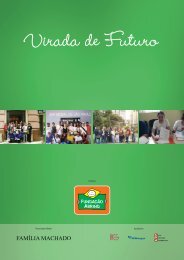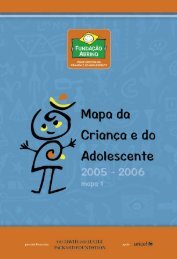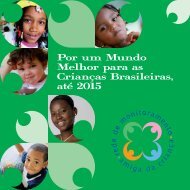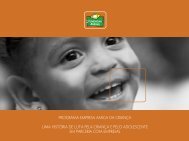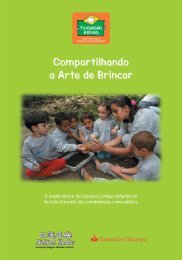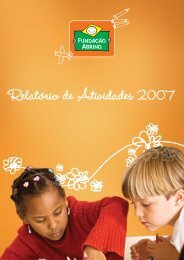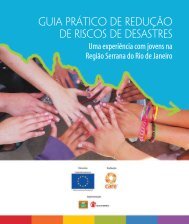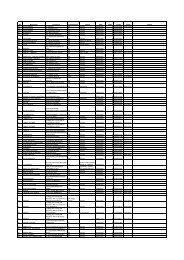Create successful ePaper yourself
Turn your PDF publications into a flip-book with our unique Google optimized e-Paper software.
Funding Partnerwas delivered personally by the <strong>Abrinq</strong> Foundation’s Special Secretary of Human Rights,Paulo Vannucchi, with the presence of representatives from the Rede de MonitoramentoAmiga da Criança and the Conselho Nacional dos Direitos da Criança e do Adolescente.<strong>2006</strong> was also significant in the 2005-2008 cycle of the Prefeito Amigo da CriançaProgram, which mobilizes and monitors municipal public administrations in the aim ofgaining their commitment and supporting them in the implantation of public policies topromote improvements in the quality of life for children and adolescents.Following an intense mobilization of the Brazilian town councils in 2005, which resultedin the compliance of 2,263 municipalities to the Prefeito Amigo da Criança Network, theprogram carried out its first assessment of the 2005-2008 administration via the Mapada Criança e do Adolescente (Children and Adolescents Map) for 2005-<strong>2006</strong> – Map I,an instrument for gathering information that also offers subsidies to the municipalitiesregarding the implementation of policies aimed at children and adolescents. 1,155 municipalitiesresponded to Map I, in other words, 20% of Brazil’s towns.The Mapa da Criança e do Adolescente for 2005-<strong>2006</strong> mobilized the municipalities participatingin the program and promoted local debate on the situations of the violation of the rightsof children and adolescents and the capacity of the public administration to deal with them.This important result translates as the implementation of Municipal Assessment Commissionsin 55% of these towns, involving the Local Councils for the Rights of Children and Adolescentsand the participation of the Public Ministry, Child Courts, representatives of the municipallegislation, of the business sector and of tutelary counsels, among other local actors in thegathering and validation of the information requested for the Map.Special mention should also be given to the inter-municipal articulation initiatives: thetown councils of Recife, in the state of Pernambuco, and of Votuporanga, in the northeasternregion of the state of São Paulo, supported and mobilized more than 40 municipalitiesin the regions to respond to the questions for Map I. Based on local initiative, inter-municipalmeetings were also held for instruction on how to fill in the documents in the states ofEspírito Santo, Tocantins and Piauí.The assessment process indicates that a number of Brazilian municipalities have come toadopt mechanisms for inter-sectorial planning, as in the case of the Orçamento Criança:731 municipalities used this methodology at some time in their budgetary planning.In order to achieve these results, and attentive to the diversity of the Brazilian municipalities,a teleconference was held and which made for an agile and efficient dialogue withthe local administrators and advisors on the rights of children and adolescents in themore than 170 points of the Sesc/Senac Television Network throughout Brazil. This actionresulted in an audience of 1,558 participants, simultaneously connected to the PrefeitoAmigo da Criança Program.The 842 municipalities that, after analysis of the Maps, received the Prefeito Amigo daCriança Seal – 1st Assessment Phase saw a return on the information sent, with recommendationsindicating which actions should be carried out in order to improve the livingconditions of children and adolescents in each location. They also received the DVD “PactoFederativo e as Políticas Sociais para a Infância e Adolescência – O Papel dos Municípios”(Federal Agreement and Social Policies for Childhood and Adolescence – the Role of Municipalities),training material regarding the Federal Agreement, which guides municipalactions and states the responsibility of the public for guaranteeing social rights.This program, which has the partnership of The David and Lucile Packard Foundation, hasa Strategic Action Committee to support the Program’s directives and actions and which isformed of nationwide organizations. The program also has the support of the DATASUS/MS– the Information Technology Department for the SUS (General Data and Technology Coordination)and of the INEP/MEC – Anísio Teixeira National Institute for Educational Studies andResearch (Educational Data Treatment and Dissemination), who provide secondary indicators.Brief background of the Presidente Amigo da Criança ProjectIn 2002, during the election campaign, the <strong>Abrinq</strong> Foundation launched the PresidenteAmigo da Criança Project, which sought the signatures of the main presidential candidateson the “Termo de Compromisso Presidente Amigo da Criança”.This vow commits the candidate to, if elected, “carrying out, in a challenging way, the significantimprovement of the numbers relating to the situation of children and adolescents in a four yearmandate, using as a reference the commitment assumed by the Brazilian Government in the UNO– United Nations Organization’s Special Session for Childhood , in May of 2002”.In order to do so, the president elect must draw up a plan of action to fulfill the goalsdefined by the UNO, to include the plan of action in the budget for the Multi-Annual Plan,to not limit access to the resources needed for carrying out the plan of action and to monitorand assess the development of the plan of action, as well as making data available andproviding accountability to a network of civilian social organizations.In the aim of monitoring the implementation of the administration commitments assumedby the president elect, to analyze the progress towards the goals in the areas of education,health and protection, to disclose the analyses and recommendations produced and tomake viable the participation of children and adolescents, the Amiga da Criança MonitoringNetwork was set up, composed of civilian social organizations, multilateral bodiesand the Rede Sou de Atitude (I’ve got Attitude Network), a youth network present in 16Brazilian states.Numbers for the Prefeito Amigo da Criança Program2,263 mayors and mayoresses make up the PPAC network, in other words, an increaseof 46.6% in relation to the previous administration (2001-2004), when theparticipation was 1,542 municipalities. There are 42,229,906 children and adolescentsliving in these municipalities.1,155 municipalities responded to the 2005-<strong>2006</strong> Children and Adolescents Map.1,074 towns implanted Municipal Commissions for evaluation and monitoring.731 municipalities adopted the Orçamento Criança methodology, in at least one of thephases of their Budgetary Planning.842 municipalities received the Prefeito Amigo da Criança Seal – 1st assessment phase.59



